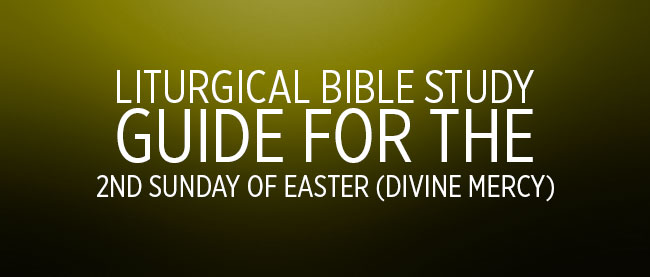Introduction
On April 30, 2000, His Holiness John Paul II, in response to the wishes of the Christian faithful, declared that “the Second Sunday of Easter henceforth throughout the Church will also be called Divine Mercy Sunday.” The desire for this celebration was expressed by Our Lord to Saint Faustina as can be found in her Diary (§699):”… My daughter, tell the whole world about My inconceivable mercy. I desire that the Feast of Mercy be a refuge and shelter for all souls, and especially for poor sinners. On that day the very depths of My tender mercy are open. I pour out a whole ocean of graces upon those souls who approach the fount of My mercy. The soul that will go to Confession, and receive Holy Communion on this day shall obtain complete forgiveness of sins and punishment…”
1st Reading – Acts 4:32-35
During the Easter season there are no readings from the Old Testament (other than the responsorial psalm). It is during this season that we read from the Acts of the Apostles and learn how the early Christian Church conducted itself. To place today’s reading into its proper context, we need to look back to Acts 2 where Peter addresses the crowd on that first Pentecost as he quotes from the prophet Joel: “17 ‘It will come to pass in the last days,’ God says, ‘that I will pour out a portion of my spirit upon all flesh. Your sons and your daughters shall prophesy, your young men shall see visions, your old men shall dream dreams. 18 Indeed, upon my servants and my handmaids I will pour out a portion of my spirit in those days, and they shall prophesy. 19 And I will work wonders in the heavens above and signs on the earth below: blood, fire, and a cloud of smoke. 20 The sun shall be turned to darkness, and the moon to blood, before the coming of the great and splendid day of the Lord, 21 and it shall be that everyone shall be saved who calls on the name of the Lord.’ 22 You who are Israelites, hear these words. Jesus the Nazorean was a man commended to you by God with mighty deeds, wonders, and signs, which God worked through him in your midst, as you yourselves know. 23 This man, delivered up by the set plan and foreknowledge of God, you killed, using lawless men to crucify him. 24 But God raised him up, releasing him from the throes of death, because it was impossible for him to be held by it.” (Acts 2:17-24). “40 He testified with many other arguments, and was exhorting them, ‘Save yourselves from this corrupt generation.’” (Acts 2:40). Recall that Jesus had said “Amen, I say to you, this generation will not pass away until all these things have taken place” (Matthew 24:34; Mark 13:30; Luke 21:32).
“42 They devoted themselves to the teaching of the apostles and to the communal life, to the breaking of the bread and to the prayers. 43 Awe came upon everyone, and many wonders and signs were done through the apostles. 44 All who believed were together and had all things in common; 45 they would sell their property and possessions and divide them among all according to each one’s need. 46 Every day they devoted themselves to meeting together in the temple area and to breaking bread in their homes. They ate their meals with exultation and sincerity of heart, 47 praising God and enjoying favor with all the people. And every day the Lord added to their number those who were being saved.” (Acts 2:42-47).
2nd Reading – 1 John 5:1-6
This first letter of John is believed to have been written from Ephesus toward the end of the first century (A.D. 67). In essence the letter deals with the love of God and of the brethren which are the hallmark of the Christian. Saint Jerome tells us that when John was a very old man his only message was, “little children, love one another.” When his disciples asked him why he was always saying the same thing he always answered “My children, this is what the Lord commands; if we do this, nothing else is necessary.”
Gospel – John 20:19-31
Saint John writes from the point of view of Jesus fulfilling Old Testament prophecies. He seeks to strengthen the faith of the early Church. In his account of the resurrected Lord, he shows how the necessary tools to continue His work were passed on.


